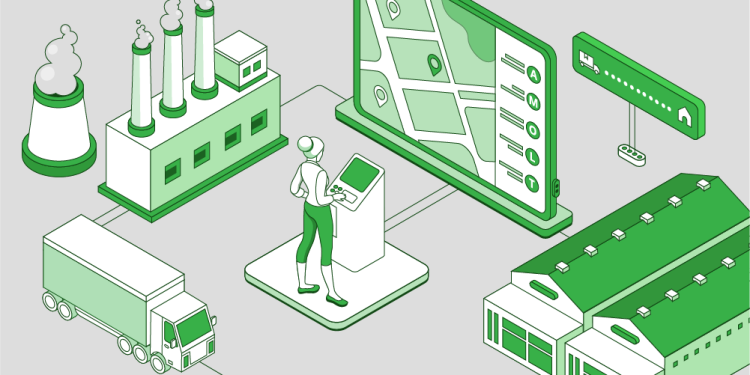Importance of Logistics Management: Why and How it Benefits Your Business?

Have you ever stopped to wonder how the shoes you ordered yesterday showed up at your door this morning? Or how your local supermarket always has fresh fruits and vegetables, no matter the weather or time of year?
It’s not magic. It’s logistics management—an essential behind-the-scenes system that keeps everything running smoothly. Whether it’s a box arriving at your home or a store being fully stocked, logistics plays a huge role in how products get from one place to another.
Why Logistics Management Is a Big Deal
Logistics is like the quiet hero of the business world. It’s all about planning, organizing, and making sure things move from one point to another quickly and correctly. When done right, it helps businesses grow, saves money, and keeps customers happy.
According to research by Accenture, supply chain issues have caused companies to miss out on up to 11% of potential growth. Another study by McKinsey found that 80% of businesses see logistics and transport as a top reason for their success. That’s a big deal.
In short: if your logistics aren’t working well, your business might lose customers, waste money, or fall behind the competition.
What Is Logistics Management?
Logistics management is the process of making sure products or materials are in the right place, at the right time, in the right condition, and in the right amount, which is why many turn to a logistic parts management system. It involves everything from storage and transportation to packing and tracking.
Think of logistics management as the conductor of a big orchestra. Every part of the system—like storage, delivery, and inventory—must work together in harmony to avoid mistakes and delays.
Logistics vs. Supply Chain Management: What’s the Difference?
People often confuse logistics management with supply chain management, but they’re not the same.
- Supply chain management is a broader term. It covers everything from getting raw materials to making products to delivering them.
- Logistics management is a part of that. It focuses only on how goods move and how they are stored, packed, and delivered.
So, logistics is like one piece of the larger puzzle.
8 Key Benefits of Good Logistics Management
1. Lower Costs
Efficient logistics can help spot weak points and fix them. By doing so, businesses can reduce waste, save time, and cut costs. Lower logistics costs also mean lower product prices for customers.
2. Better Visibility
Good logistics systems make it easy to track every step of the process—from factory to front door. This means problems can be spotted and fixed faster.
3. Happier Customers
Did you know that 32% of customers won’t return to a store after just one bad experience, like a late delivery? Fast, reliable delivery is key to keeping customers happy—and coming back.
4. Lower Overhead
Smart logistics helps businesses use just the right amount of warehouse space. This avoids paying for space that isn’t needed and helps reduce operating costs.
5. Risk Management
Delays, damage, or theft can hurt a business. Logistics planning helps find these risks early and puts backup plans in place, so surprises don’t become big problems.
6. Environmentally Friendly
With better logistics, companies can reduce fuel use and lower emissions. Not only is this better for the planet, but it also builds trust with eco-conscious customers.
7. Stay Ahead of the Competition
If you can deliver faster and more reliably than others, customers will notice. Logistics gives you that edge by making sure you’re always on time and accurate.
8. Supports Business Growth
When logistics are well-managed, it’s easier to handle more orders and expand into new markets without trouble. That’s key for any business looking to grow.
The 7 R’s of Logistics Management
There’s a simple way to remember what logistics is all about: the 7 R’s. They are:
- Right Product – Make sure the correct item is sent.
- Right Quantity – Deliver the amount that was ordered.
- Right Condition – Products should arrive safely and without damage.
- Right Place – Deliver to the correct location.
- Right Time – Arrive on time, every time.
- Right Customer – Make sure the package goes to the right person or business.
- Right Cost – Keep costs fair and competitive.
These seven points are the foundation of a successful logistics strategy.
How Flowcharts Help Logistics Management
A logistics flowchart is a visual tool that shows the step-by-step process of how goods move from one stage to another. These are useful for:
- Warehousing – Managing how products are stored, picked, and packed.
- Transportation – Planning delivery routes and maintaining vehicles.
- Delivery – Ensuring that products reach customers quickly and safely.\
Benefits of Logistics Flowcharts
- Clearer Processes – Flow Charts make it easier to understand and explain each part of the system.
- Fewer Mistakes – With a clear plan in place, errors are less likely to happen.
- Lower Costs – Well-planned steps help avoid delays and waste.
- Better Customer Experience – Fast and correct deliveries mean happy customers.
Final Thoughts
Logistics management is more than just moving boxes around. It’s a key part of every business that wants to serve its customers well, grow, and stay competitive. When done properly, logistics saves time, reduces waste, and boosts profits.
Ignoring logistics can lead to late deliveries, higher costs, and unhappy customers. That’s why companies should always look for ways to improve how they manage logistics. Partnering with experienced logistics providers can also make a big difference, especially for businesses that are growing fast or delivering in large volumes.






